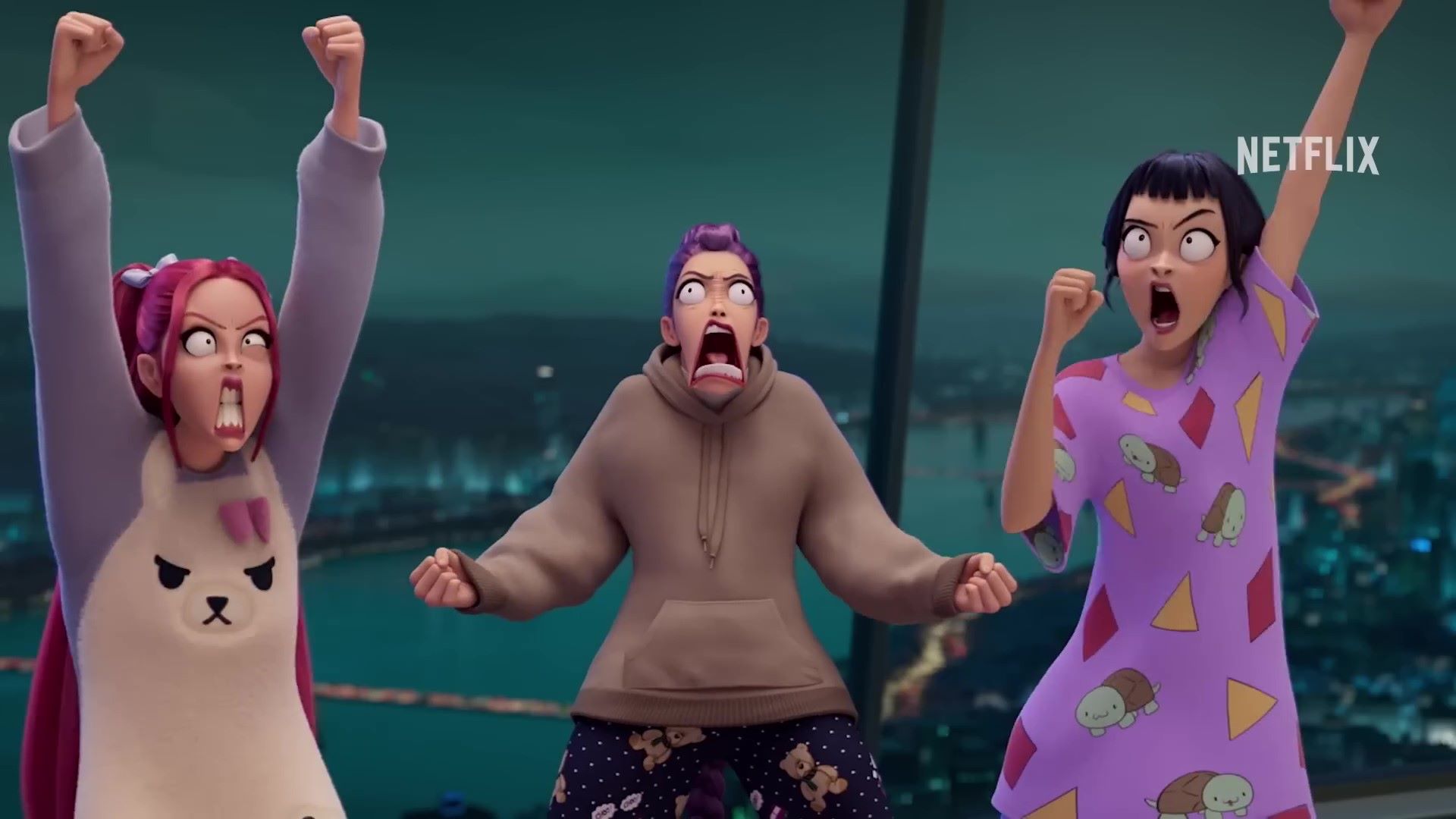K-Pop Demon Hunters Review: A Vibrant, Heartfelt Animated Triumph

When I first heard about KPop Demon Hunters, a Netflix animated film blending the high-octane world of K-pop with supernatural demon-slaying action, I was intrigued but skeptical. Could a movie combining such wildly different genres—K-pop stardom and demon hunting—really work? Having attended the film's limited theatrical release at AMC Lincoln Square in New York City before its Netflix debut, I can confidently say it doesn’t just work; it’s a dazzling, emotional, and visually stunning ride that’s as catchy as the music it celebrates. Directed by Maggie Kang and Chris Appelhans, this Sony Pictures Animation gem has quickly become a global sensation, and it’s easy to see why. Here’s my deep dive into what makes KPop Demon Hunters such a standout. Where to Watch: KPop Demon Hunters is currently streaming on Netflix worldwide and playing in select theaters including AMC, Regal, and Cinemark locations across major cities. The theatrical experience, with its booming surround sound system, truly elevates the musical sequences—something I noticed immediately when comparing my theater viewing to my subsequent Netflix rewatch at home.
A Wild Premise That Pays Off
At its core, KPop Demon Hunters follows Huntrix, a K-pop girl group made up of Rumi (voiced by Arden Cho), Mira (voiced by May Hong), and Zoey (Ji-Young Yoo). By day, they’re chart-topping idols filling stadiums with their infectious music. By night, they’re secret demon hunters tasked with protecting the world from soul-sucking supernatural forces led by the menacing demon king Gwi-Ma (voiced by Lee Byung-hun). The film’s high-concept premise—think Sailor Moon meets Buffy the Vampire Slayer with a K-pop twist—sounds absurd on paper, but the execution is nothing short of brilliant.
The story kicks off with a voice-over explaining that for generations, girl groups have used their music to trap demons underground, keeping humanity safe. Huntrix is the latest in this lineage, on the verge of completing the “Golden Honmoon,” a mystical barrier to seal away evil forever. But their mission gets complicated when they face a new threat: the Saja Boys, a rival demon boy band led by Jinu (Ahn Hyo-seop, with vocals by Andrew Choi), who aim to steal Huntrix’s fans and unleash chaos. What follows is a whirlwind of music, action, and heartfelt drama that keeps you hooked from start to finish.
Visuals That Pop Off the Screen
One of the first things that struck me was the film’s breathtaking animation. Sony Pictures Animation, known for pushing boundaries with films like Spider-Man: Into the Spider-Verse, delivers a visual feast that blends 3D animation with a distinctly 2D, anime-inspired flair. The character designs are vibrant and detailed, with each member of Huntrix sporting a unique style that reflects their personality—Rumi’s fierce elegance, Mira’s cool aloofness, and Zoey’s bubbly charm. The demon-hunting sequences are a highlight, with flashy choreography and dynamic camera movements that feel like a mix of Arcane’s intensity and The Powerpuff Girls’ playful energy.
The film leans into its Asian influences with comic-book-style touches, like when Zoey’s eyes morph into heart shapes or six-pack abs when she spots the Saja Boys. These quirky details add humor and charm, making the action sequences as visually appealing as they are thrilling. Having covered animation festivals and studied Sony Pictures Animation's evolution since Spider-Verse, I can confidently say this represents their most culturally authentic work to date. The world-building also incorporates Korean folklore, with adorable animal sidekicks like a grinning tiger demon and a black bird in a tiny gat (traditional Korean hat), giving the film a distinct cultural flavor that feels authentic and lovingly crafted.
A Soundtrack That’s an Instant Playlist Add
No K-pop-inspired movie would be complete without a killer soundtrack, and KPop Demon Hunters delivers in spades. The original songs, penned by a mix of Western artists and K-pop heavyweights like TWICE’s Jeongyeon, Jihyo, and Chaeyoung, are absolute bangers. The lead single, “Takedown,” is a braggadocious anthem that perfectly captures Huntrix’s confidence and swagger. Every performance scene is a visual and auditory spectacle, with choreography that rivals real K-pop music videos and vocals (provided by EJAE, Audrey Nuna, and Rei Ami) that are so catchy I found myself humming them long after the credits rolled. During my theater viewing, the bass-heavy "Takedown" sequence literally made my seat vibrate—an experience that Netflix's home audio, even with a decent sound system, simply couldn't replicate.
The music isn’t just there for show—it’s woven into the story. Huntrix’s songs are their weapons, using rhythm and melody to trap demons, which gives the musical numbers a narrative purpose that feels organic. Whether it’s a high-energy battle anthem or a softer ballad exploring the characters’ vulnerabilities, the soundtrack is a standout, earning praise from critics for its “top-notch” quality and earworm appeal.
Characters You Can’t Help But Root For
The heart of KPop Demon Hunters lies in its characters. Rumi, the group’s laser-focused leader, carries a secret: she’s a hybrid of human and demon, marked by purple imprints that tie her to the very creatures she fights. Her struggle to balance her identity and leadership responsibilities adds depth to her character, and Arden Cho’s voice acting brings a raw intensity to her performance. Mira, the aloof choreographer, and Zoey, the bubbly rapper, complement Rumi perfectly, forming a trio whose chemistry feels like a real friend group. Their banter and support for each other make every emotional beat hit harder.
The Saja Boys, particularly Jinu, add another layer of intrigue. Jinu’s backstory as a human-turned-demon with a mysterious past makes him more than just a villain, and his budding romance with Rumi is a delightful surprise. While the rom-com subplot is somewhat predictable, it’s handled with sincerity, culminating in a twist that left me unexpectedly moved. As someone who's analyzed dozens of K-pop narratives and character arcs, I was impressed by how the film avoids typical villain stereotypes and creates genuinely complex antagonists. The film’s message about vulnerability—showing that it’s okay to embrace your flaws and lean on those who care about you—resonates deeply, especially in scenes where the characters confront their insecurities.
A Few Minor Hiccups
No film is perfect, and KPop Demon Hunters has a couple of flaws. Some critics have noted third-act pacing issues, where the story rushes through its climax a bit too quickly. A subplot about Rumi’s voice struggles feels underdeveloped, slowing down the momentum without adding much to the narrative. Additionally, the exposition-heavy opening might overwhelm viewers unfamiliar with the K-pop or anime influences the film draws from. But these are minor gripes in an otherwise exhilarating experience. The film’s infectious energy and heartfelt moments overshadow any stumbles, making it easy to forgive its shortcomings.
Why It’s a Must-Watch
KPop Demon Hunters is a love letter to K-pop culture, animated storytelling, and the power of friendship. It takes a seemingly ridiculous premise and turns it into something magical, blending genres with a confidence that’s both refreshing and inspiring. The animation is a visual triumph, the music is impossible to resist, and the characters feel like friends you’d want to root for in real life. Critics have praised its “infectious rhythm” and “heartfelt sincerity,” with Rotten Tomatoes reporting a 92% score based on early reviews, and IMDb users giving it a solid 7.8/10.
For fans of K-pop, anime, or just great storytelling, this film is a must-watch. It’s the kind of movie that leaves you smiling, singing, and maybe even a little teary-eyed. I walked away wanting to rewatch it immediately—and yes, I’ve already added the soundtrack to my playlist. If you’re looking for a film that’s equal parts fun, flashy, and heartfelt, KPop Demon Hunters is ready to slay your expectations.
My Recommendation: If you have access to both options, I'd suggest catching it in theaters first for the full audio-visual experience, then rewatching on Netflix to catch details you might have missed. The film works beautifully in both formats, but there's something special about experiencing those musical sequences with theater-quality sound that enhances the emotional impact.

About the Author
Alex Chen
K-Pop Culture & Animation Expert
Alex Chen is a Korean Wave culture researcher and animation film critic with over 5 years of experience analyzing the K-pop industry. Holding a Master's degree in East Asian Studies, Alex has contributed to major entertainment publications including Variety Asia and The Hollywood Reporter. With fluency in Korean, English, and Chinese, Alex brings deep cultural insights to K-pop and Asian animation content analysis.
Expertise & Credentials:
- M.A. in East Asian Studies
- 5+ years K-pop industry analysis
- Animation film critic & consultant
- Contributor to Variety Asia & THR
- Fluent in Korean, English, Chinese